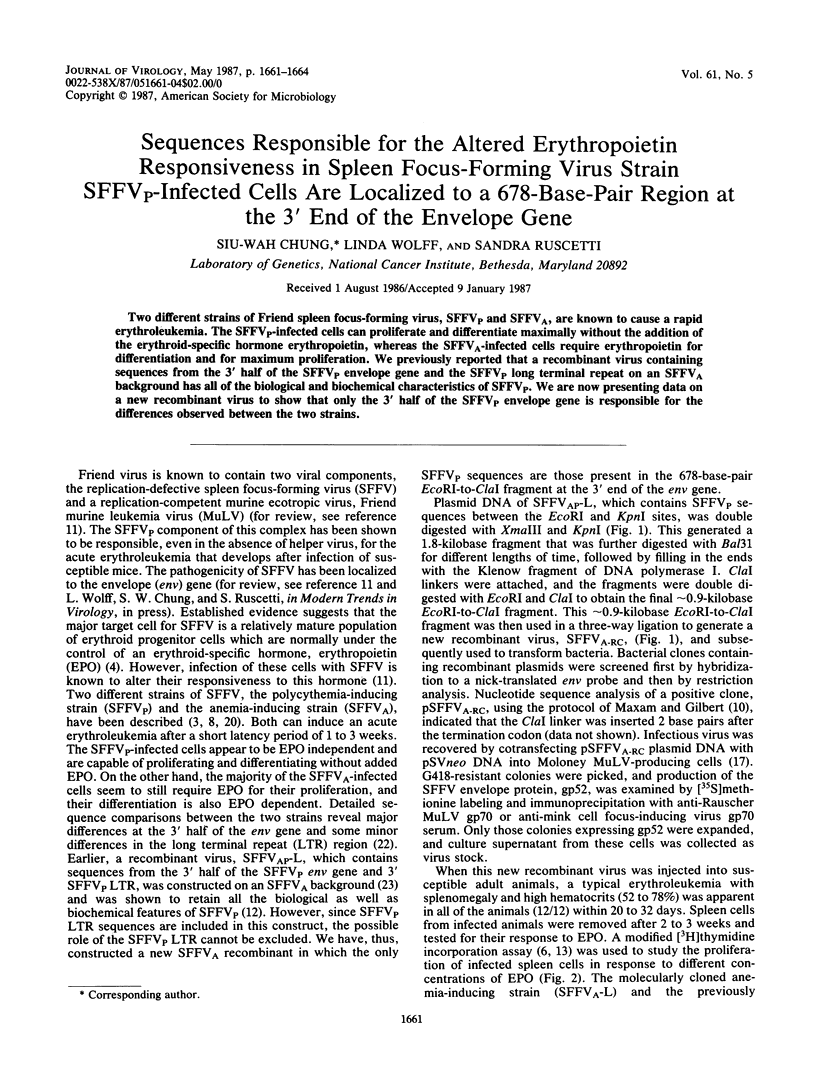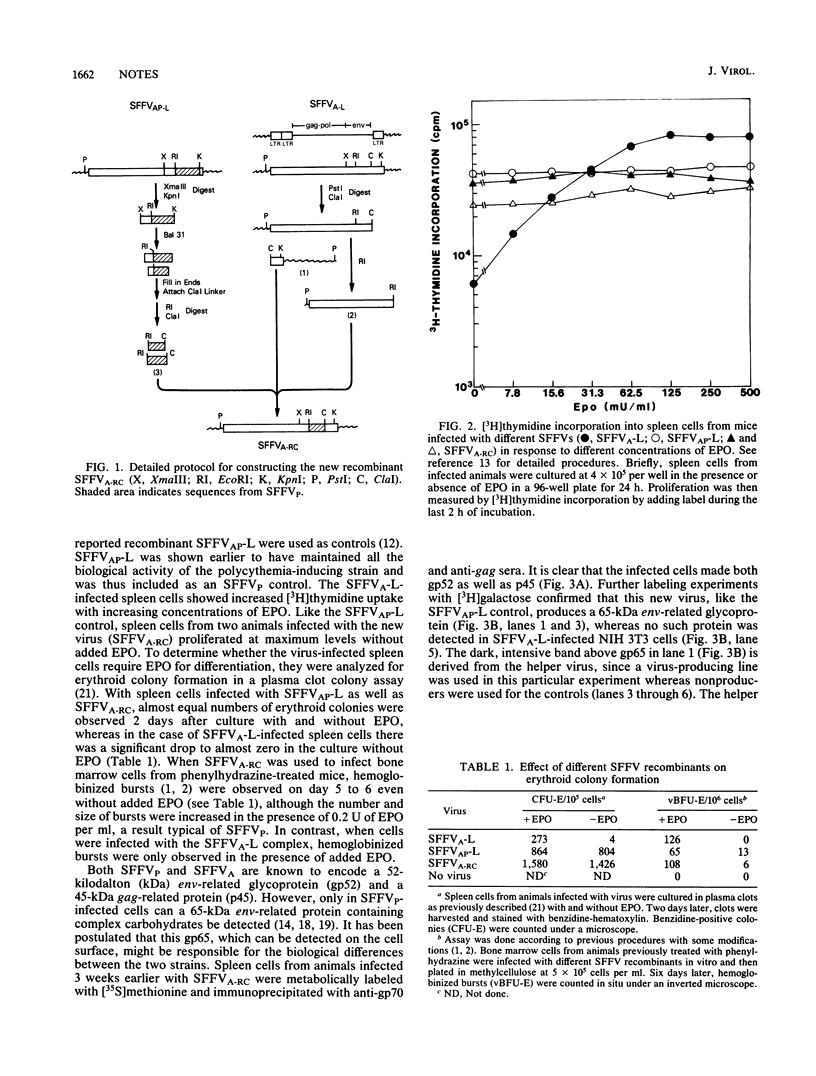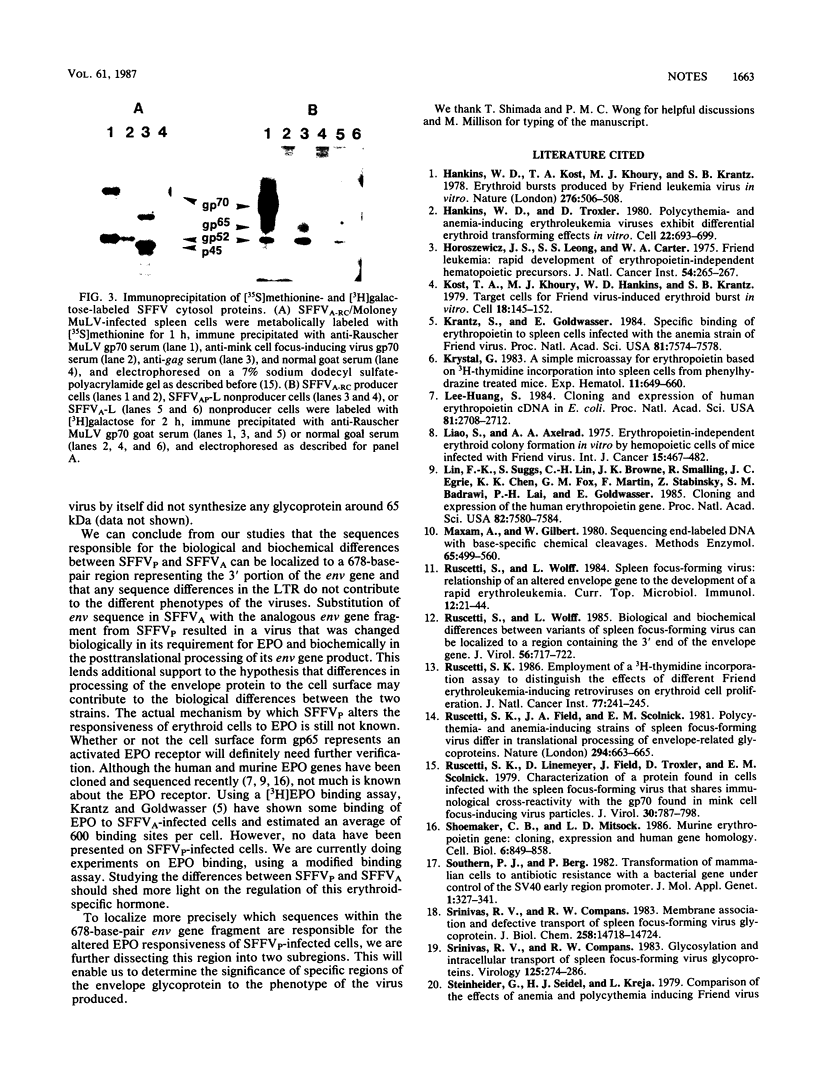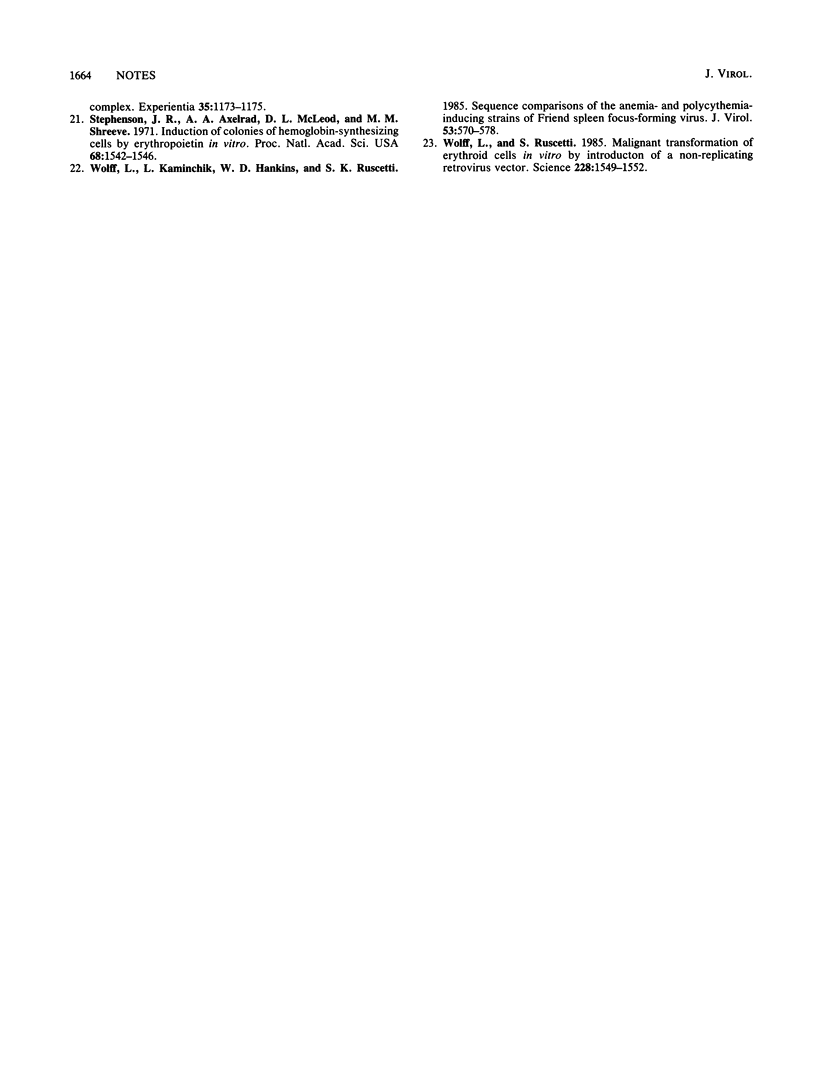Abstract
Two different strains of Friend spleen focus-forming virus, SFFVP and SFFVA, are known to cause a rapid erythroleukemia. The SFFVP-infected cells can proliferate and differentiate maximally without the addition of the erythroid-specific hormone erythropoietin, whereas the SFFVA-infected cells require erythropoietin for differentiation and for maximum proliferation. We previously reported that a recombinant virus containing sequences from the 3' half of the SFFVP envelope gene and the SFFVP long terminal repeat on an SFFVA background has all of the biological and biochemical characteristics of SFFVP. We are now presenting data on a new recombinant virus to show that only the 3' half of the SFFVP envelope gene is responsible for the differences observed between the two strains.
Full text
PDF



Images in this article
Selected References
These references are in PubMed. This may not be the complete list of references from this article.
- Hankins W. D., Kost T. A., Koury M. J., Krantz S. B. Erythroid bursts produced by Friend leukaemia virus in vitro. Nature. 1978 Nov 30;276(5687):506–508. doi: 10.1038/276506a0. [DOI] [PubMed] [Google Scholar]
- Hankins W. D., Troxler D. Polycythemia- and anemia-inducing erythroleukemia viruses exhibit differential erythroid transforming effects in vitro. Cell. 1980 Dec;22(3):693–699. doi: 10.1016/0092-8674(80)90545-0. [DOI] [PubMed] [Google Scholar]
- Horoszewicz J. S., Leong S. S., Carter W. A. Friend leukemia: rapid development of erythropoietin-independent hematopoietic precursors. J Natl Cancer Inst. 1975 Jan;54(1):265–267. doi: 10.1093/jnci/54.1.265. [DOI] [PubMed] [Google Scholar]
- Kost T. A., Koury M. J., Hankins W. D., Krantz S. B. Target cells for Friend virus-induced erythroid bursts in vitro. Cell. 1979 Sep;18(1):145–152. doi: 10.1016/0092-8674(79)90363-5. [DOI] [PubMed] [Google Scholar]
- Krantz S. B., Goldwasser E. Specific binding of erythropoietin to spleen cells infected with the anemia strain of Friend virus. Proc Natl Acad Sci U S A. 1984 Dec;81(23):7574–7578. doi: 10.1073/pnas.81.23.7574. [DOI] [PMC free article] [PubMed] [Google Scholar]
- Krystal G. A simple microassay for erythropoietin based on 3H-thymidine incorporation into spleen cells from phenylhydrazine treated mice. Exp Hematol. 1983 Aug;11(7):649–660. [PubMed] [Google Scholar]
- Lee-Huang S. Cloning and expression of human erythropoietin cDNA in Escherichia coli. Proc Natl Acad Sci U S A. 1984 May;81(9):2708–2712. doi: 10.1073/pnas.81.9.2708. [DOI] [PMC free article] [PubMed] [Google Scholar]
- Liao S. K., Axelrad A. A. Erythropoietin-independent erythroid colony formation in vitro by hemopoietic cells of mice infected with friend virus. Int J Cancer. 1975 Mar 15;15(3):467–482. doi: 10.1002/ijc.2910150313. [DOI] [PubMed] [Google Scholar]
- Lin F. K., Suggs S., Lin C. H., Browne J. K., Smalling R., Egrie J. C., Chen K. K., Fox G. M., Martin F., Stabinsky Z. Cloning and expression of the human erythropoietin gene. Proc Natl Acad Sci U S A. 1985 Nov;82(22):7580–7584. doi: 10.1073/pnas.82.22.7580. [DOI] [PMC free article] [PubMed] [Google Scholar]
- Maxam A. M., Gilbert W. Sequencing end-labeled DNA with base-specific chemical cleavages. Methods Enzymol. 1980;65(1):499–560. doi: 10.1016/s0076-6879(80)65059-9. [DOI] [PubMed] [Google Scholar]
- Ruscetti S. K. Employment of a [3H]thymidine-incorporation assay to distinguish the effects of different Friend erythroleukemia-inducing retroviruses on erythroid cell proliferation. J Natl Cancer Inst. 1986 Jul;77(1):241–245. [PubMed] [Google Scholar]
- Ruscetti S. K., Feild J. A., Scolnick E. M. Polycythaemia- and anaemia-inducing strains of spleen focus-forming virus differ in post-translational processing of envelope-related glycoproteins. Nature. 1981 Dec 17;294(5842):663–665. doi: 10.1038/294663a0. [DOI] [PubMed] [Google Scholar]
- Ruscetti S. K., Linemeyer D., Feild J., Troxler D., Scolnick E. M. Characterization of a protein found in cells infected with the spleen focus-forming virus that shares immunological cross-reactivity with the gp70 found in mink cell focus-inducing virus particles. J Virol. 1979 Jun;30(3):787–798. doi: 10.1128/jvi.30.3.787-798.1979. [DOI] [PMC free article] [PubMed] [Google Scholar]
- Ruscetti S., Wolff L. Biological and biochemical differences between variants of spleen focus-forming virus can be localized to a region containing the 3' end of the envelope gene. J Virol. 1985 Dec;56(3):717–722. doi: 10.1128/jvi.56.3.717-722.1985. [DOI] [PMC free article] [PubMed] [Google Scholar]
- Ruscetti S., Wolff L. Spleen focus-forming virus: relationship of an altered envelope gene to the development of a rapid erythroleukemia. Curr Top Microbiol Immunol. 1984;112:21–44. doi: 10.1007/978-3-642-69677-0_2. [DOI] [PubMed] [Google Scholar]
- Shoemaker C. B., Mitsock L. D. Murine erythropoietin gene: cloning, expression, and human gene homology. Mol Cell Biol. 1986 Mar;6(3):849–858. doi: 10.1128/mcb.6.3.849. [DOI] [PMC free article] [PubMed] [Google Scholar]
- Southern P. J., Berg P. Transformation of mammalian cells to antibiotic resistance with a bacterial gene under control of the SV40 early region promoter. J Mol Appl Genet. 1982;1(4):327–341. [PubMed] [Google Scholar]
- Srinivas R. V., Compans R. W. Glycosylation and intracellular transport of spleen focus-forming virus glycoproteins. Virology. 1983 Mar;125(2):274–286. doi: 10.1016/0042-6822(83)90201-5. [DOI] [PubMed] [Google Scholar]
- Srinivas R. V., Compans R. W. Membrane association and defective transport of spleen focus-forming virus glycoproteins. J Biol Chem. 1983 Dec 10;258(23):14718–14724. [PubMed] [Google Scholar]
- Steinheider G., Seidel H. J., Kreja L. Comparison of the biological effects of anemia inducing and polycythemia inducing Friend virus complex. Experientia. 1979 Sep 15;35(9):1173–1175. doi: 10.1007/BF01963269. [DOI] [PubMed] [Google Scholar]
- Stephenson J. R., Axelrad A. A., McLeod D. L., Shreeve M. M. Induction of colonies of hemoglobin-synthesizing cells by erythropoietin in vitro. Proc Natl Acad Sci U S A. 1971 Jul;68(7):1542–1546. doi: 10.1073/pnas.68.7.1542. [DOI] [PMC free article] [PubMed] [Google Scholar]
- Wolff L., Kaminchik J., Hankins W. D., Ruscetti S. K. Sequence comparisons of the anemia- and polycythemia-inducing strains of Friend spleen focus-forming virus. J Virol. 1985 Feb;53(2):570–578. doi: 10.1128/jvi.53.2.570-578.1985. [DOI] [PMC free article] [PubMed] [Google Scholar]
- Wolff L., Ruscetti S. Malignant transformation of erythroid cells in vivo by introduction of a nonreplicating retrovirus vector. Science. 1985 Jun 28;228(4707):1549–1552. doi: 10.1126/science.2990034. [DOI] [PubMed] [Google Scholar]



